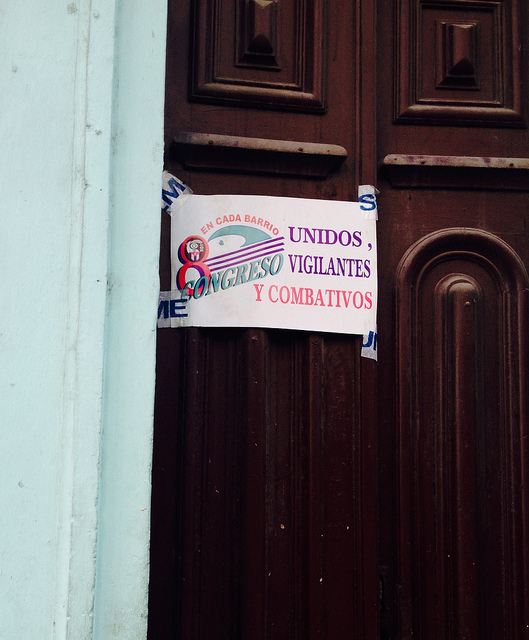
Author: Yoani Sánchez
What’s Happening in Ukraine? / Yoani Sanchez
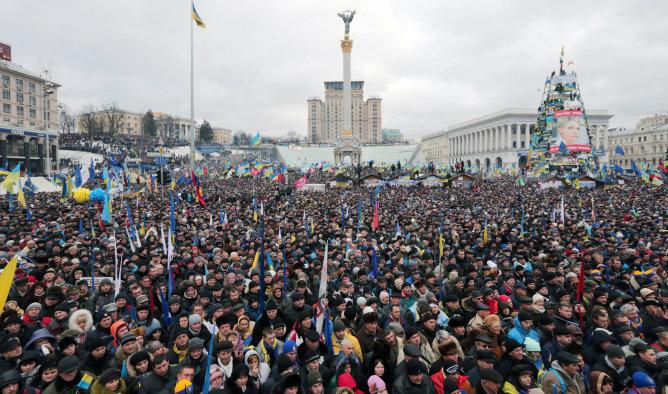
The official Cuban media reports, immediately, when the citizens of the world’s imperfect democracies take to the streets. In these cases the words “injustice,” “capitalism” and “exploitation” are used by the court’s newscasters to explain the whys of such social protests. Something very different occurs if the protestors rise up against an authoritarian regime, or against a government “friendly” to the Plaza of the Revolution. In that case, the informative script is peppered with qualifiers such as “mercenaries,” “financed from abroad”…”insurgents” or the “so-called rebels.” The people are not people everywhere… this hemiplegic analysis seems to want to tell us.
Occasionally, however, something doesn’t fit within the strict patterns of our national press. This week with the events in Ukraine, for example, the Communist Party’s political news reports have seemed disoriented. Verbal malapropisms, caution and even actual stuttering, have been heard on TV from the mouths of those reporters who are most combative when addressing other topics. Why is what happened in the former Soviet republic so upsetting to them?
In the first place, because with Russia, the USSR’s old information pact of never questioning its foreign policy or reporting on its internal problems, has been left behind. Hence the awkwardness of reporting the popular rejection of President Viktor Yanukovich for preferring to approach the Kremlin instead of Brussels. In this scheme designed by the Department of Revolutionary Orientation, the European Union is to be vilified and whatever it does called into question whenever possible. Thus, it is now difficult for the same media to explain why so many Ukrainians are demanding to become a part of this political community.
Given the apparent contradiction, the newscasters choose to play down the news and limit the use of images of the crowded squares in Kiev. Instead, they accompany the reports with several scenes from inside the Kremlin, with the announcers insinuating that some foreign power is behind the revolt. Twenty-four hours after the first note we haven’t heard anything more.
I imagine that many viewers, like me, watching that incoherent sequence, are asking themselves, “What? What’s happening in the Ukraine?” But the official press can’t answer us, because they can’t even fulfill their role of telling us what’s happening in Cuba.
9 December 2013
Animal feed, then… more feed / Yoani Sanchez
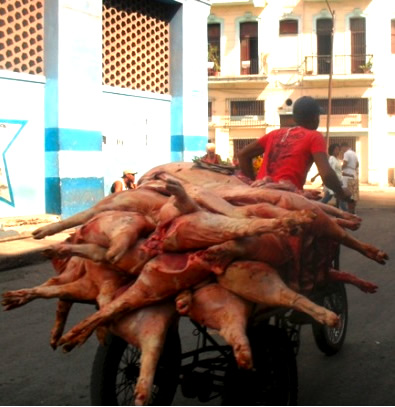
It’s five in the morning and they are beginning to pile a few pieces of port on the stand. They’ve made the long and rugged journey from a private farm to get to this market in the city. They will only have meat to sell until mid-morning, because the demand exceeds what the sellers can offer. A good part of the domestic economy will be determined by this product. Its rising price affects the cost of a steak sandwich that a bricklayer might eat at his work site, or that of the chicharrones that a mother puts on the table for her children’s lunch. So many things revolve around those extra pounds of fat, bone and fibers, that any shortage or lack affects the everyday fabric of survival.
However, behind the chops and sausages is a product as important as it is difficult to get: the feed for the pigs. The weakest link in the agricultural chain is “food for the pigs,” a real headache for many Cuban peasants. The State remains the leading manufacturer of this product, in part because the private sector doesn’t have the raw materials or the technical capacity to obtain it.
After decades pf accumulated complaints and of underweight animals, Cuba still has not managed to achieve stable high quality nutrition for farm animals. Traveling through the fertile plains that make up the western and central areas of the county, one is surprised by the great amount of uncultivated land. It could be planted with grains and vegetables that would help to increase the mass of the country’s swine. For now, these extensive land abound in weeds.
The State entities sell pigs after they are weaned, and also part of the feed they consume, to the producers. The farmers incur a debt that they will repay with the animals themselves after they are slaughtered, leaving some profit for themselves. Explained in this way, it seems fair. However, the whole process is full of irregularities, diversion of resources and corruption. The functionaries of the agricultural sphere sometimes falsify the weights, artificially increasing what they deliver to the farmers and reducing what they receive from them. In addition, the distribution of the feed is not completed, or simply never occurs.
To be able to fatten the animals, the private producer then uses products that are contraindicated for the health of the consumers. Excessive doses of antibiotics, food scraps collected from garbage dumps in the large cities, and even the offal and remains of the pigs themselves. In some cases so-called “fishmeal” will be the only thing the pigs ingest in their brief lives, giving the meat a now characteristic flavor in many Cuban dishes.
When a pound of pork is slaughtered, in most cases it’s because feed is scarce. A close relationship that alters the domestic economy and quality of life for so many Cubans. It starts with a sack of feed that doesn’t arrive on time to the farm trough, but ends with a woman who leaves the market with an empty sack.
8 December 2013
Chimeras, Transitions and Stages / Yoani Sanchez
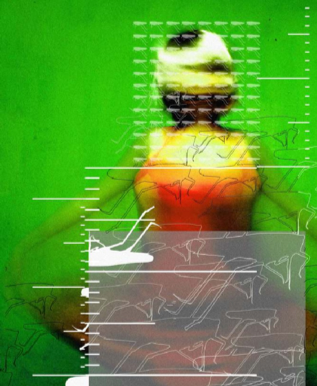 The article that I published in Issue 19 of the journal Voices
The article that I published in Issue 19 of the journal Voices
“Every frustration is the daughter of an excess of expectations,” a friend repeated to me when the forecasts of beautiful tints that I invent every now and then fell short. The last decades of my life — like that of so many Cubans — have been a kind of unfulfilled forecasts, scenarios that never materialize, and archived hopes. A sequence of cabals, rites of divination and staring at the moon, that collide head-on with the stubborn reality. We are a people of frustrated Nostradamuses, of soothsayers who won’t win at life, of prophets who weave predictions together, without getting any of them right.
In our national history the nineties held the greatest concentration of failed prognostications. I remember imagining people in the street, the shouts of freedom, the pressures of need and social misery exploding in a peaceful revolt that would change everything. I was a teenager and we were a beardless society… we still are. So the mirage of before and after, of an event that would again split the calendar of the nation, of our going to bed one night thinking of political change and before the sun set again it would be done. Like all immature people, we believed in magicians. In those who will come with a wand or banner or dais, to resolve everything.
And then it happened. Although it didn’t seem anything like what I had imagined. We had the Maleconazo in August of 1994, but what brought people to the streets wasn’t an attempt to transform the country from within, but rather to bypass the insularity and escape to another place. There was no flag waving, no shouts of “Viva Free Cuba!” Rather doors were torn off to make rafts with a long delayed goodbye on our north coast. My wise friend repeated it… “I told you, you’re disappointed because you always expect too much.”
Two decades have passed, our society never matured but some stubborn gray hairs started to appear on my head. I now know that between desire and events most of the time there is a divorce, an uncomprehending widow. I became pragmatic, but not cynical. Everything I learned about reality — paraphrasing a good poet — was not everything there was in reality. When I woke up thinking “this system already died,” then its capacity to be the “living dead” for fifty-four years bit me.
So now I’ve stopped believing in the solutions accompanied by smiles and hugs in the street. Hard times are coming. The transition will be difficult and there won’t even be a day to celebrate it. Most likely there will be joy and singing. We have been late to everything, even change. The images of the Berlin Wall falling to pieces were only possible once. For us, and here I venture another prophecy, there will be a gray transformation, without snapshots to record it.
A day after the Castros… if after the Castros there is a day.
One day we will look back and realize that the Castro regime fell or simply ceased to exist, taking with it the best years of my mother, my best years, the best years of my son. But perhaps it’s just as well, not having another January first, no photos of Greek-profiled gentlemen with pigeons perched on their shoulders. Perhaps a change that goes through the waters of apathy is better than another carnivorous revolution that devours us all.
Afterwards, afterwards there won’t be much time for festivities. The bubble of false statistics will pop and we’ll be struck by the country we actually have. We’ll realize that the infant mortality rate isn’t what we’ve been told all these years, that we aren’t the “most cultured people in the world” and that the nation’s coffers are empty… empty… empty. We will hear a chorus of “with Raul Castro everything was better.” We will have to start to change the name of the Stockholm Syndrome and relocate it to this tropical geography.
Responsibility will come, a concept few are prepared for. Taking over our own lives and putting “Daddy State” in its rightful place, without protectionism but also without authoritarianism. Democracy is profoundly boring, so we’ll get bored. That permanent fear that we listen to, that panic that a neighbor or friend could be an informer for State Security, will no longer exist. Then we will see if we dare to say out loud what we are thinking, or if we prefer that the politicians of tomorrow can comfortably manage our silence.
The first free elections will find us arriving early at the polling stations, talking and smiling. But by the third or fourth time the turnout at the polls will be around half the population. Being a citizen is a full-time job and, as you already know, we are not used to efficient and constant work, nor to tenacity. So eventually we’ll again delegate our responsibility to some “sweet talking” populist who promises us paradise on earth and assures us that in the dilemma between “security and freedom” he will be charged with enforcing the first. We will fall into his trap, because we are an immature people, a beardless people.
The scars will take a long time to fade, but the new wounds are rapidly appearing. This combination between high level professional and low level ethics will be a bitter pill for us to swallow. It wouldn’t surprise me if we become an emporium of drug manufacturing and trafficking. This would be another of the many legacies left to us by the Castro regime: a predatory people, where the word “values” is uncomfortable… and unnecessary.
Lurching to the fiercest consumption also seems inevitable. Years of rationing, shortages and pitiful goods with outdated labels, will make people hungrily throw themselves at the market. Time will pass before we see environmental movements, natural food movements, or we are called to moderation and to not be wasteful. The appetites to have, to buy, to show off, will skyrocket and will also be a part of the sequels left to us by a system that preaches austerity while the higher ups exercise hedonism.
We will see them mutate, like chameleons swearing “I never said such thing.” We will watch them exchange ideology for economics, their Manual of Marxism for a Guide to Business, their olive-green uniforms for suits and ties. They will speak of necessary reconciliation, of forgetting, and remind us that “we are all one people.” They will go from acts of repudiation to amnesia, from spying to continuing to spy because once an informer, always an informer.
Every person who was once critical of the government will be, for these “converts” of tomorrow, deeply uncomfortable. Because to look at them will be a reminder that they did nothing to change things, that, from cowardice and opportunism, they kept their mouths shut. So among their objectives will be to bury what was once the Cuban dissidence. They will use it and set it aside. We will hear stories of people beaten and incarcerated being told by the forgotten old men of social security; like today we see Olympic boxers begging on the street. The medals of the past will be offensive to the cynics of the future… there will be no space for heroism, because it’s uncomfortable.
The dates celebrated in the textbooks will change. Many statues will be removed and in their place they will erect some whose names we will have to learn and at whose bases we will have to leave flowers on their anniversaries. One epoch will be replaced, another will be established. With all those who will then say they were opponents and helped “to overturn the Castro regime” we could, right now, establish a civic force of millions of individuals. There will be a competition to see who is more responsible for the change and has more medals to hang on their lapels.
Bad predictions, good preparation
Tired of throwing flowers at the future and imagining its luminosity, I have come to believe that the more we paint it in dark tones the more energy we can put into changing it. The time to think about tomorrow is now because the Castro regime has died but still walks, breathes, tightens its fist. The Castro regime has died because its life cycle expired some time ago, its cycle of illusion was brief, its cycle of participation never existed. The Castro regime has died and we must begin to plan for the day after its funeral.
I look forward to reading proposals and platforms that address the dilemmas that will confront us one hour after the coffin of this so-called revolution rests under the earth. Where are the programs for that moment? Are we prepared for this gray change, without heroes or falling walls, but that will inevitably come to pass? Do we know how we are going to face the new problems that will arise, the problems that will appear on all sides which are here now, but muted and distorted?
If we prepare ourselves for the worst case scenario, it will be a sign of maturity that will help us overcome it. The civic network will play a key role in any case. Only by strengthening this civic structure can we stop ourselves from falling into the arms of the next political hypnotist or into networks of chaos and violence. We are not looking for presidents — they are already here — we are looking for citizens.
Let’s forget the river of people celebrating in the streets and the Ministry of the Interior opening its archive to find out who was and wasn’t an informant. Most likely, it won’t be like that. The enthusiasm for public demonstrations is exhausted and the most revealing documents will no longer exist, they will have burnt them or taken them. We have come late to the transition. But that doesn’t mean it will go badly for us, that we will regret taking it on.
We can, this at least we can, start from scratch in so many things. Drinking in the experiences and disasters of others; realizing that we have the chance to sow the seeds of democracy in world where so many try to straighten a trunk that was born crooked. If our change turns out badly, we will have half the planet pointing at us and asking, “Is that what they wanted for Cuba? Is that the change they yearned for?” With no apologies, we have a responsibility not only to our nation, but to the better part of humanity that believes it can still transition successfully from an authoritarian to a participative system.
Realization is the daughter of a difficult challenge
I know what my skeptical friend will say when reading this article. He will chuckle and say, “Even when you’re pessimistic you’re still a dreamer.” But he will also recognize that I am no longer that teenager who hoped to one day wake up to cries of joy in the street, to join the crowd and head to the statue of José Martí in Central Park. I know it won’t be like that. But it can be much better.
6 December 2013
Teaching with Humor / Yoani Sanchez
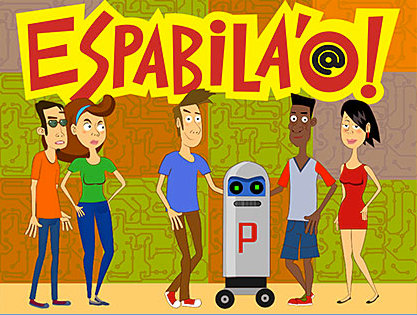
I had a long discussion with a friend about the genius or lack of same of a certain political personage. He insisted that the power to quote extensive passages of text and to remember dates and the names of historic figures, was evidence of his brilliance. But, I pointed out to him, I’ve never heard him make a joke, nor deliver a well constructed irony. He lacks humor, I concluded, and humor is evidence that a person has a superior intellect. I have always believed that bringing a smile to others is more difficult than generating fanaticism in a multitude. Not only in the case of public figures, but also in education. To teach in a fun way can foster better connections with students. We tend to remember better what we have learned while entertained, versus through weary predictability.
This is the case with the knowledge of computer security that comes to us through the new videogame game Espabilao. Quimbumbia, its group of Cuban developers, has made this incredibly instructive amusement available to the citizens of the Island. It is the story of Pix, a robot, who must protect the personal data that his naive owner, Ale, has left scattered around the Internet. The protagonist’s tasks focus on improving the strength of passwords, detecting, in time, websites that could capture private information, and eliminating navigational hazards. A story told with humor and cleverness, but also with years of knowledge accumulated by internauts, digital activists and cyberspace users. Learning through cunning and seemingly playful challenges, but deriving much needed and serious results.
After coming to know the Quimbumbia project and Espabilao, its latest offering, I now have another element to convince my skeptical friend. “You see,” I will tell him, “sharpness doesn’t have to be so boringly serious, nor does teaching have to make you want to yawn.” Probably he will carry on with his examples of pompous orators and statistics that overwhelm the statisticians. I, however, prefer the approach practiced by Pix… the laughter that accompanies it teaches us and leaves what we learn indelibly etched in our memory. Humor, I continue to believe, is the most complete display of human genius… which is why the mediocre and the authoritarian are so bad at it.
The post Enseñar con humor appeared first on Generación Y – Yoani Sánchez.
26 November 2013
The Future, Questions and Predictions to Break / Yoani Sanchez
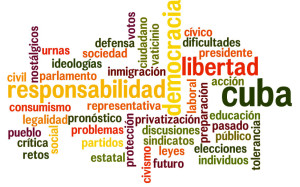
Ten prognostications, ten failures, ten predictions that did not even make it to a dead letter. This is what a Decalogue of possible future prognostications — personal and national — that would have been made in 2003 has been reduced to. Such that, knowing the twisted paths events take, today I am trying to imagine the surprises in store for us in the next decade. I know — at least I know this — it will be difficult, very difficult times are coming for everyone. To forget, as we go to bed one night, the huge problems we do indeed have, and pretend we will wake up to another day, isn’t going to happen. It’s very naive to believe we can shake off this totalitarianism and all that will result from it. It’s not going to happen, new problems and new challenges will begin. Are we prepared for them?
Are we prepared for a society where the responsibility lies with us and not with the State? A country where we can choose a president, but where he could perhaps turn out to be corrupt, a liar, an authoritarian? Are we capable of realizing, in that case, that we voted to name a “father,” rather than a public servant who answers to us? How long will it take for us to lose our suspicions about everything that contains the world “social” or about the unions, who today are simply transmission poles for the powers-that-be to the workers? Are we ready for tolerance? Can we live together peacefully with those of other political viewpoints and ideologies who take the microphones and propose their programs? Will our inexperience, perhaps,l launch us into the arms of the next populist? Are we aware that we will experience a Cuba where, most likely, there will be a lot of nostalgia for the Castro regime? What will we do if, instead of real change, those who are now part of the Nomenklatura exchange their olive-green uniforms for the suits and ties of entrepreneurship?
How will we react to immigration? Right now we only know the phenomenon of those who leave and also those visitors who — briefly — come as tourists to our land. However, we must know that if we manage to build a prosperous country, others will come to stay. How will we receive them? What will be the effects of so many years of shortages and rationing on personal consumption? Will families put themselves deeply in debt buying everything they see on TV? How will we resolve the dilemma of State property versus privatization? Will it be possible to maintain the extensive educational and hospital infrastructure throughout the country, while improving its quality, breaking the bonds of ideology, and paying employees dignified salaries? What will happen to the enormous governmental and official apparatus, whose costs fall on our shoulders to an extent we can barely conceive of?
As you can see, rather than certainties, I only have questions. Questions that haunt me when I speak of the future of my nation. At least some things are clear to me: I will be in Cuba, I will do everything I can to help my country and will try — through journalism — to dispel many of these doubts or to amplify them until someone responds.
The post El futuro, preguntas y vaticinios por romper appeared first on Generación Y – Yoani Sánchez.
Are We Caring for the Environment in Cuba? / Yoani Sanchez
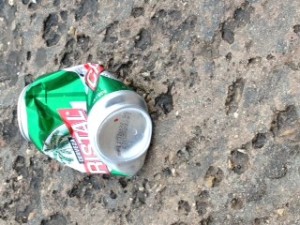
A man dressed like a mechanic pours liquid from a tank into the sewer. A few yards away, two boys are scrubbing a motorcycle and the soapy water runs off onto the ground, watering the roots of some nearby trees. Several neighbors have set fire to a pile of trash: dry leaves, branches, but also a couple of batteries, a portable radio and even a laser printer cartridge. After re-using it a dozen times, the restaurant cook pours the burned oil down the sink, that is if he doesn’t take it home for his family to eat. The hairdresser upstairs does the same thing, when she tosses the used hair dye down the toilet. This irresponsibility in the treatment of waste products extends across the entire Island. Few are aware of the ecological damage caused by ordinary daily activities.
Separating trash such as cardboard and glass, which is natural to others, seems like a chimera in a country that hasn’t even solved the problem of efficient trash collection. Even today the containers on the corners overflow, bringing the flies, health hazards and stink that now make up an inseparable part of cities like Havana. Thus, it’s hard work to awaken awareness in a population whose priorities still center on the so-called community services working at all. However, much of the damage that we are causing to the environment is irreversible, and requires urgent measures to slow it down as quickly as possible.
The State sector is the greatest predator of our ecosystem, with its enormous factories that spew chemicals into rivers and the oceans, its many sugar plants without oxidation ponds, and its thousands of vehicles that don’t meet environmental standards. In addition, all this is hidden by the absence of transparency, the falsification of statistics and the prohibition on independent organizations that could address such behaviors. Nevertheless, we as citizens also have to share a good part of the blame.
The lack of an environmental mindset is felt in every detail of our lives. It’s notable, for example, the self-confidence with which so many Cubans cut down a tree, cement over their backyard where plants used to grow, throw chemical products into the water, mistreat and kill animals, or simply toss out recyclable materials. It’s not enough to ask children in elementary school to plant a bean seed to foster in them a love of nature. It’s also not enough to show ads on prime time TV calling on us to preserve the planet on which we live. Caring for the environment has to become a part of educational programs, strictly addressed in the law, and promoted in all areas.
The emerging civil society should also adopt this banner. Without lowering the torch of human rights and democratic changes, it’s time for civic movements to create environmental defense strategies for this Island we will bequeath to our children. Groups that report incidents against the ecosystem, organize recycling training programs, and try to protect natural resources should all take on a leading role. It’s great that we want the coming generations to be free, but we must start by guaranteeing we have a country to bequeath to them.
The clock is ticking. Nature does not wait. Tomorrow there will be no turning back.
The post ¿Cuidamos el medio ambiente en Cuba? appeared first on Generación Y – Yoani Sánchez.
24 November 2013
The Illusion of Color / Yoani Sanchez
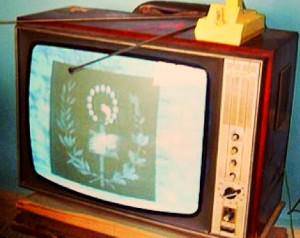
I got home from school and there was a man sitting on the floor in front of the TV. His fingers were stained with paint and some oil-paint tubes were scattered around him. It was the latest fad in the neighborhood: painting a colorful pattern on those boring black-and-white screens. The first one to do so was the downstairs neighbor, always up-to-date with the latest trends, which included posters of lightly-clad women taped to the walls, and an enormous porcelain tiger at the entrance to her home. She dictated fashion throughout the whole tenement, so when she transformed her “boob tube” with a rainbow in reds and blues, everyone imitated her. In my house at 218 Krim, they painted some stripes and even a central circle in various tones. Most significant is that years later, I remembered the programs and cartoons I saw on that “invention” as if they’d come to me in their original polychrome. My brain had joined the shades and constructed the illusion of color.
This personal anecdote comes to me when I read the latest 2012 Statistics from the Census of Population and Housing. On learning that there are still more than 700,000 black-and-white TVs in Cuba, I can’t help but evoke the excited neighbors of my tenement using their fingertips to paint their cathode ray tubes. But in the current figures, there is not only evidence that they are still watching TV programming in black, white and gray… but also that they are economically worse off in our country. They are the ones who have failed to get together the convertible pesos for a modern Sony or LG. Those who probably have no family abroad, who haven’t found a way to divert State resources, or whose privileges ended with the end of the USSR. The poorest who, in a society of such avid TV watchers, don’t have the resources to enjoy the tonalities.
I wonder if any of those old TVs touched up with stripes in green, purple and cyan still survive… If some child on this island still watches like my sister and me did, mentally joining a piece of color here and another there to imagine Huckleberry Hound was a blue dog, or Cheburashka with his fur brown.
Now I no longer know, I can no longer distinguish in my memory, between what came to me thanks to the ingenuity of painted screens, or what I enjoyed years later thanks to Technicolor.
The post La ilusión del color appeared first on Generación Y – Yoani Sánchez.
23 November 2013
Cuban Airports: The Chokepoint / Yoani Sanchez

People crowd together in the suffocating heat, some are holding signs with names printed on them. The flight from Madrid just landed at José Martí International Airport, bringing tourists and many nationals now living in Spain. Each person must wait forty minutes to an hour — at least — before finally passing through the exit door. Havana is one of the world’s slowest airports, the worst lit, and with the fewest services for the traveler.
In a country that receives almost three million tourists a year, updating its airport facilities is vital for the economy. If these places don’t meet international standards, it’s unlikely that the island — in the short or medium term — can play host to more visitors.
Aware of its major shortcomings, ECASA (Cuban Airports and Aeronautical Services S.A.) has begun a process of remodeling some of its arrival and departure lounges, but the problem requires more than adjustments and redesign. Its principal limitations are not only material, but also its excessive controls, the lack of comfort, and the attitudes of its employees.
Departure lounges, restrictions and inadequacies
Alina has arrived at the Havana airport three hours early, but it may not be enough. She can check in only at the airline counter, as there are no machines to perform the procedures independently. This limitation lengthens the lines, slows the whole process of obtaining a boarding pass, and feeds the image of an always crowded lounge that characterizes José Martí Airport.
A frequent traveler to Spain, thanks to her new EU passport, Alina has come prepared for a cramped and awkward process. She flies through Terminal 2 because Terminal 3 — larger and more modern — is being remodeled and recently experienced a fire. In her bag she carries a snack made at home, because she knows the prices there are stratospheric and the offerings are very limited.
Poor signage completes the picture. For ten minutes the frustrated customer looks for a bathroom but the directional signs are scarce and not very visible. Few of the ceiling lights are on, which makes the various areas of the lounge dark. Still, every passenger must pay the airport tax. In the line to hand over 25 convertible pesos ($28 US), one hears the tourists complaining about the tenuous relationship between the price and the quality of the facilities. Cuban passengers, however, remain silent, not wanting to cause problems for themselves just when they’re about to leave the island.
Without a Wi-Fi network to access the Internet, any modern airport falls several points on the scale of quality. With regards to communication, no embarkation point in Cuba is competitive, not even Varadero. The few public phones and the lack of a wireless network diminish the chances to communicate. To this is added the TVs buzzing away with their tired tourist announcements or overly ideological programs like Cubavision’s Roundtable. Nor is there a stand selling magazines or newspapers, just some souvenir kiosks where they sell the works of Ernesto Guevara and the speeches of Fidel Castro.
Alina is also prepared to avoid boredom while waiting, and has brought some headphones to listen to music on her phone. She waits at the exit doors — there are only two: A and B — until an employee shouts out that her flight is already checking in.
Arrivals and the collision with reality
 Humberto arrives after a trip to the United States. This was his first trip abroad, so he’s still stunned by the size of the Miami airport. On the plane back to Cuba he’s filled out the Customs form and in his pocket he has a copy of the boarding pass he got at the exit. He joins the long line for immigration and next will have to answer a brief medical questionnaire which he will also have to sign. A few steps away the luggage waits, the slowest point in the entry to Cuban territory. Every suitcase will be put through a scanner to investigate its contents.
Humberto arrives after a trip to the United States. This was his first trip abroad, so he’s still stunned by the size of the Miami airport. On the plane back to Cuba he’s filled out the Customs form and in his pocket he has a copy of the boarding pass he got at the exit. He joins the long line for immigration and next will have to answer a brief medical questionnaire which he will also have to sign. A few steps away the luggage waits, the slowest point in the entry to Cuban territory. Every suitcase will be put through a scanner to investigate its contents.
After analyzing each bag or suitcase, they will attach “markers” to those that need to be inspected. A small red strip tied to the handle may mean it contains some home appliance or computer. If instead, it contains an external hard disk, then they write some initials on the paper strip that identifies the flight. There is no way to avoid this process. The customs officers are trained to keep out a long list of objects.
Humberto’s granddaughters, born in Coral Gables, have given him a laptop and a smartphone. So he must go to the table where they open his suitcase and minutely search everything. They take the computer to an office, where they probably inspect its files or make a copy of them. He’s already waited an hour and a half since the plane touched down and will probably wait a little longer.
While they search his belonging they tell him he can’t make calls on his cellphone. “Welcome to Cuba,” he tells himself when an officer asks what those “bullet-shaped” pressed cotton things are. “Tampons for my daughter,” he responds grumpily.
Two hours after arriving in his own country, Humberto passes through the gate in Terminal 2. At the same time, Alina is already seated on her flight to cross the Atlantic. Looking out the window she whispers, “Goodbye Havana airport, I hope I don’t see you for a long time!”
The post Aeropuertos cubanos: el nudo en el embudo appeared first on Generación Y – Yoani Sánchez by Yoani Sánchez
17 November 2013
My Kitty Vinagrito / Yoani Sanchez
To the memory of Teresita Fernández.
Why did that song of the kitty Vinagrito touch our souls so deeply? I don’t think the answer is the children’s visual wasteland we experienced in the seventies and eighties, filled almost entirely with the productions Made in the USSR or other Eastern European countries. Nor is it found indirectly in the human search for recognition, already so brilliantly described in The Ugly Duckling by Hans Christian Andersen. No, it wasn’t just that, although these, too, could be enumerated as some of the reasons to repeat the catchy chorus.
The story of Vinagrito, the cat rescued from the street, had that sweet sensitive side missing from so many socialist camp cartoons. These were sober, tragic or instructive enough, but they lacked the melodrama spiced with touches of humor and ridicule that define the Cuban identify. With his name alone — a diminutive of the vinegar used in cooking — the crazy-haired feline already made us love him and mock him at the same time. There, we found a story of rejection, redemption and transformation. Vinagrito managed to become what no one expected of him: a beautiful and happy pet, calmly dipping his whiskers in his milk.
It was hard not to identify with the “ugly and skinny” guy picked up off the street, when so many of us also felt that the “outside” represented a loss of self and the end of the individual. Vinagrito returned — instead of us — to a home with the warm embrace of a family, surrounded by attention. He was rescued, while we were lost. He ended up at home, while so many of us were leaving for a dorm, a camp, a platoon. He meowed to the moon… while we chased an ideological mirage.
It was nice to have his tail and his taste for the fish, without him everything would have been so much more boring.
11 November 2013
Soccer and Soap Operas / Yoani Sanchez
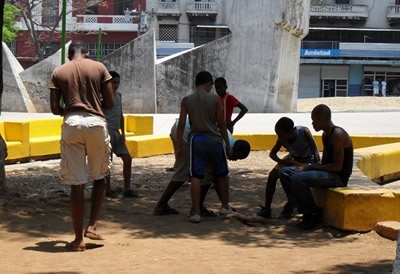
“When the teachers aren’t listening, what do the students in your classroom talk about?” I asked my son a few months ago. He barely paused before answering. “The boys talk about football and the women about telenovelas,” he replied, sure of himself. I confess, I expected more. I had imagined slightly risqué topics like sexuality, or problems such as drug use or, in some cases, political controversies. But no, the long minutes of the breaks between one class and another are dominated by Messi, Cristiano Ronaldo, and the latest wickedness of the Brazilian soap and its heartthrob who shows his face on the small screen every week.
My first reaction was dismay. “If, at the most rebellious age, this is what they talk about… we’re in bad shape.” But then I stopped myself. I was not going to fall into what older people had warned me of when I was a teenager. “Your generation is lost,” they told me, followed by an enumeration of everything they themselves had accomplished. So, before answering Teo, I tried to understand why the reality of the country, its serious problems and possible solutions, occupy so little time — or none — in our young people’s conversations. Apathy, escapism, indifference… were some explanations. After the initial moment of disappointment, I felt relief. Comforted knowing that even this inertia is a way of bringing the current system to an end.
The Cuban model needs people who applaud wildly, committed soldiers, ideologically convinced individuals. Indolence will never be the soil where rebellion grows, nor will it foster partisan fervor. As I’ve said many times, “I prefer apathy over fanaticism.” From apathy, one can wake up, from fanaticism, I have my doubts. Frivolity is also corrosive to a sober and outdated totalitarianism.
These young people of today, they still have plenty of time for their civic consciousness to awaken.
10 November 2013
The Magic Lantern Is Switched Off / Yoani Sanchez
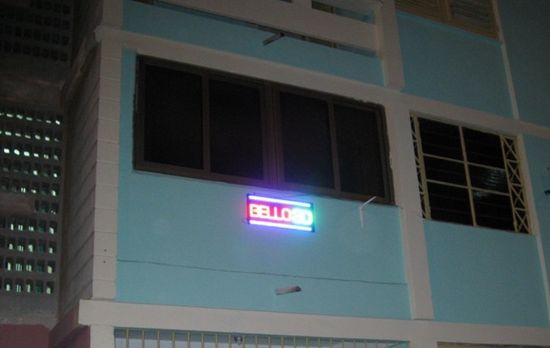 Robert is closing down his 3D movie business. He has put a price on the projector, the glasses, and even the popcorn machine. He was only three months into the business knows he can’t recover his investment. A briefing note in the official Cuban press ended his entrepreneurial plans. He was forces to close the same week he had planned to start showing children’s movies in his air-conditioned room with cushy armchairs.
Robert is closing down his 3D movie business. He has put a price on the projector, the glasses, and even the popcorn machine. He was only three months into the business knows he can’t recover his investment. A briefing note in the official Cuban press ended his entrepreneurial plans. He was forces to close the same week he had planned to start showing children’s movies in his air-conditioned room with cushy armchairs.
Of the more than 442,000 self-employed workers in this country, a good share of them have been affected in recent weeks by new legal restrictions. The Granma newspaper announced the immediate closing of the private movie and videogame rooms, suggesting that these had never been permitted.
Certainly the list of the more than 201 private licenses don’t include film projection, nor computer rooms devoted to entertainment. However, entrepreneurs have taken advantage of a small crack in the law, to operate. In a short time, these “neighborhood theaters” began to appear all over the country, some luxuriously appointed, some very modest.
Perhaps something that annoyed the State is that the three-dimensional projectors were introduced to the country by private hands. Or that the once powerful Cuban Institute of Cinematographic Art and Industry (ICAIC) saw that some small businesses got ahead of them on implementing such a new technology. The State apparatus sees itself threatened with losing the monopoly over the broadcast of audiovisual and places where it happens.
On the other hand, the private 3D rooms brought a lot of people back to the idea of neighborhood movie theaters. For example, in mid-20th century Havana, including the municipalities of Regla, Guanabacoa and Marianao, was host to 134 movie theaters. Some of them with between 1,000 and 2,500 seats, including lower level and balcony. The main ones came to have even as many 5,000 seats, like the Payret, the Radio Central (currently the Yara), the Metropolitan, the Blanquita (today the Karl Marx).
Of these, only 12 theaters remain active, largely in the most central parts of the city. The concept of nearby and intimate space, where you could go most Sundays, is unknown to Cubans under 30. So this opening of movie rooms by the self-employed, awakened memories in some and surprised others.
The programming of these new spaces, was based primarily on action, horror and animated movies. Halloween night, 48 hours before the ban that would close them, the 3D film rooms showed a wide range of “nightmare” movies. It was an advance premonition to what their owners would experience two days later. Spiderman, Avatar and Jack and the Giants were some of the productions that paraded across the private screens. Entertaining movies with no major artistic flights, but very popular among Cuban youth and children.
At the last congress of the government-sponsored Hermanos Saíz Assocation — an organization of young artists — one of the most striking approaches was their coming out against movies promoted by the private cinemas that are “frivolous, banal and consumerists.” We must “return to the principles of the cultural policy of the Revolution,” some cries. It was only a matter of time before the government ban would fall in the private theaters. Because it was known that the Cuban government, given a choice between extending the limits of the current legality, or maintaining it despite the reality, I would opt for the second.
Fear of independent dissemination of information, a political strenght-testing gesture, a backward step in the economic reforms. All this and more is hidden behind the new restrictions against 3D movies and videogames. However, it’s difficult to control a phenomenon that has gained so much popularity and whose technological infrastructure is already in the hands of so many Cubans.
Many, unlike Roberto who is unloading his equipment, plan to continue underground. The magic lantern will shine again behind closed doors, more discreetly, without neon signs, and without the aroma of popcorn escaping from the room.
6 November 2013
From Doorways to Catalogs / Yoani Sanchez
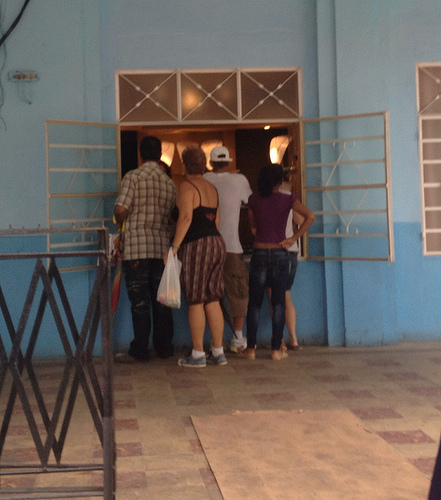
In an album for weddings there are photos of blouses, pants, shoes. They aren’t good photos, but you can see the labels and brands, which is most important to the buyers. They have everything: evening wear, tennis outfits, socks for teenagers, sportswear, underwear. Most of the goods come from Panama and Ecuador, but they also come through Terminal 2 at the international airport. So-called “mules” bring them on flights from Miami, and also through Nassau and the Cayman Islands. Ephemeral fashions, trendy colors, synthetic fabrics, big names painted on the fabric, it all fills the precarious catalogs displayed door-to-door.
The so-called private “boutiques” or “trapi-shopping” (‘trapi’ comes from the word for ‘rag’), have been hit hard legally in recent weeks. After becoming a growing phenomenon in the country’s most central doorways and streets, they’ve now been given an ultimatum to clear out their merchandise. They have until 31 December to sell what they already have in stock, but 2014 will be “a year free of imported clothing sales by the self-employed.” That privilege will be enjoyed only by State stores, where a bathing suit can cost three-month’s wages. Merchandise that is old, poor quality, and out of style, meant the government stores couldn’t match the more modern and cheaper offerings provided by the private sector.
Reluctant — or unable — to compete, the Cuban State has put an end to the business of “trapi-shopping.” Several of the best-known and air-conditioned places have already closed their doors to the public. Some have invested in redecorating their living rooms to receive their customers, having seen that their prosperous business days are numbered. However, as happens in a country with so many prohibitions, some are already looking for a solution to the current crisis. For now, they are shifting from doorways to catalogs; from on-site sales to in-home shopping. No law can stop people from looking for what they need. So they will go underground, continuing to sell skirts, shorts, sandals… with that aura, so attractive, of the new and forbidden.
The post Del portal al catálogo appeared first on Generación Y – Yoani Sánchez by Yoani Sánchez
Two Currencies, Two Realities / Yoani Sanchez
 The lady counts the coins before leaving home: she has fifty-five cents in convertible pesos. It is the equivalent of a full day’s pay and barely fills a corner of her pocket. She already knows what she is going to buy… the same as always. She has enough for two chicken bouillon cubes and a bar of bath soap. So eight hours work is just enough to flavor some rice and work up a few suds in the bathroom. She belongs to that Cuba that still calculates every price in national currency — the Cuban peso — a part of the country that doesn’t receive remittances, has no special privileges, no family abroad, no private businesses, nothing going on under the table.
The lady counts the coins before leaving home: she has fifty-five cents in convertible pesos. It is the equivalent of a full day’s pay and barely fills a corner of her pocket. She already knows what she is going to buy… the same as always. She has enough for two chicken bouillon cubes and a bar of bath soap. So eight hours work is just enough to flavor some rice and work up a few suds in the bathroom. She belongs to that Cuba that still calculates every price in national currency — the Cuban peso — a part of the country that doesn’t receive remittances, has no special privileges, no family abroad, no private businesses, nothing going on under the table.
Just before arriving at the store to buy her Maggi cubes, she stops to stare at those drinking beer at a snack bar. Every can of this refreshing drink is the equivalent of two days’ pay. However the place is full, packed with couples and groups of men who talk loudly, drink, try some of the food. It is the other Cuba, with hard currency, with relatives abroad, with their own businesses or some other illicit source of income. The abyss between the two is so great, the divide so major, they seem to be running in parallel, never touching. They have their own fears, different dreams.
When the beginning of a timeline to eradicate the dual currency was announced this week, the two countries that converge on this Island reacted differently. The Cuba that lives only on its miserable wages felt that finally they had started to put an end date to an injustice. They are those who cannot even have a photo taken on their birthday, pay for a collective taxi, nor imagine themselves traveling anywhere. For them, any process of unifying the currencies can only bring hope, because it couldn’t be any worse than it is now. The other country, in convertible pesos, received the news with great caution. How will the exchange rate change relative to the dollar or the euro? How much will the buying power of those who live better today be devalued? Their thoughts were pragmatic.
In a society where the social abyss is increasingly unfathomable and economic inequalities grow, no measure helps everybody, no relaxation will make life better for each person. Twenty years of monetary schizophrenia have also created two hemispheres, two worlds. It remains to be seen whether a simple change of banknotes can bring closer these two countries that comprise our reality, these two dimensions. If it can make it so that the lady who — almost always — eats rice flavored with a little soup cube, can one day sit down in a snack bar and order a beer.
The post Dos monedas, dos realidades appeared first on Generación Y – Yoani Sánchez by Yoani Sánchez
26 October 2013
Havana Havana, Your Fountains Are Broken / Yoani Sanchez
 I’m in the same park where thirty years ago my sister and I ran and played. Two girls turning pirouettes similar to ours hide behind some bushes. However, there is something very different in this deja vu: missing is the fountain with its sound of rain falling on marble. With rare exceptions, a very similar panorama repeats itself in every Havana plaza. Scarcity, negligence or urban policy, no one can explain it, but in recent decades this city has lost the moist presence of its fountains.
I’m in the same park where thirty years ago my sister and I ran and played. Two girls turning pirouettes similar to ours hide behind some bushes. However, there is something very different in this deja vu: missing is the fountain with its sound of rain falling on marble. With rare exceptions, a very similar panorama repeats itself in every Havana plaza. Scarcity, negligence or urban policy, no one can explain it, but in recent decades this city has lost the moist presence of its fountains.
Guided by my memory, I decided to take a water tour. At the corner of Belascoaín and Carlos III all that is left of that pond where we dunked our hands and sometimes our feet is an empty tank. A few blocks further on, rusted iron marks the site of one of the more ephemeral fountains of my memory. It only lasted a few weeks after its inauguration in an official event, speech and all. Known as “Paulina’s bidet,” near Sport City, now and again downpours turn it into a greenish lake with tadpoles. And don’t even talk about the Fountain of Youth — drab and decrepit — so close to the sea, so far from its former glory.
In a brief investigation of why this city has lost so many sources, I find varied and revealing answers: “The problem is they stole the pump that supplies the water,” an official told me. At another site an annoyed employee assured me, “We had to close it because some people ended up bathing here, because they don’t have showers in their homes.” The nicest was a lady who looked at me with narrowed eyes while reproaching me, “Oh my, what a tremendous memory you have, this fountain hasn’t worked for decades.” In the center of Plaza Vieja stands one of the few that still functions, surrounded by an imposing fence, to keep the neighbors from taking the precious liquid bucket by bucket. My water tour ended, desert-like, at the well-known La India fountain, also without a drop of H2O.
As residents of this city we must do something so that our children can experience the beauty of parks with fountains. I know there are other priorities to be resolved, but how gray is the asphalt, how solitary a little square and how oppressive the heat without this sound of water skipping over the stones.
The post Habana, Habana, la fuente se rompió appeared first on Generación Y – Yoani Sánchez by Yoani Sánchez
16 October 2013
